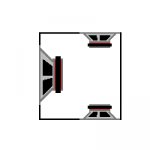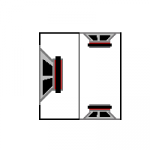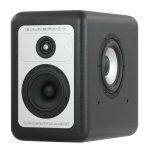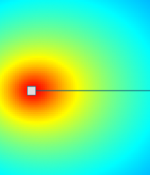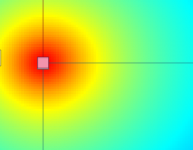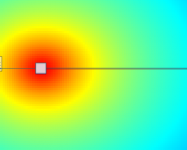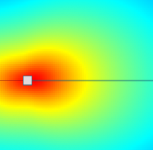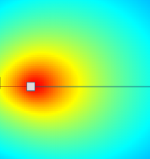I apologize for the insistence, but I need to find the perfect design for the cardioid subwoofer.
For an active cardioid subwoofer, which of the following two designs is better?
1 Dual monopole with a delay (with a single closed box), like Kii Three
or
2 Dual monopole with a delay (with two boxes closed)
For an active cardioid subwoofer, which of the following two designs is better?
1 Dual monopole with a delay (with a single closed box), like Kii Three
or
2 Dual monopole with a delay (with two boxes closed)
Attachments
Number one is better (Lower amplifier requirement and voicecoil heating), but harder to get the DSP right because of the driver interaction. DSP for the second arrangement is quite straight forward to set up because it doesn't require iterating towards a workable result. Don't forget the required delay, you only mention the phase inversion further up. Bruno's engineers probably had a mathematical solution, which is beyond me.
I've only done front-rear shared volume cardioids without the phase rotation to go monopole at low frequencies.
I've only done front-rear shared volume cardioids without the phase rotation to go monopole at low frequencies.
Last edited:
Number 1 looks like a serious engineering project with drivers interacting and need to (over?)compensate for pressure in addition to required delay corrections. Looks like complicated box and software design. If the back to front(or left to right) can be managed by baffle/box design and delays, then Number 2 would be more doable. All changes in box and drivers, will change the required DSP programming.
"A cardioid speaker can be made with two opposite polarity monopole sources separated by a distance D, and with the signal to one of the sources delayed by a time T = D/c."
"An implementation of this concept could be a driver in a box of depth D where the rear wall is an acoustic resistor R. At long wavelengths the box internal air volume behaves as a compliance or acoustic capacitor C. The acoustic output from the rear of the box is low-passed by the RC filter and delayed relative to the front output by T = RC."
- Siegfried Linkwitz
Frontiers
So then, either adding drivers or an acoustic resistor with a good frequency response could do the trick for being cardioid. I guess that is the Kii audio and ME Geithain starting point.
"An implementation of this concept could be a driver in a box of depth D where the rear wall is an acoustic resistor R. At long wavelengths the box internal air volume behaves as a compliance or acoustic capacitor C. The acoustic output from the rear of the box is low-passed by the RC filter and delayed relative to the front output by T = RC."
- Siegfried Linkwitz
Frontiers
So then, either adding drivers or an acoustic resistor with a good frequency response could do the trick for being cardioid. I guess that is the Kii audio and ME Geithain starting point.
Last edited:
Yes, pretty much the same aim and the same result.
It's just that my (opinionated) engineering brain tells me that the Kii approach is the brute force method and Geithain the elegant one.
But brute force is cheap these day and it is ultimately easier, cheaper and quicker to diy so why not?
One area where brute force and elegance come together is with active bass traps but all this is a bit OT.
PS: I would give all woofers involved a separate chamber. Avoids a lot of potential problems.
It's just that my (opinionated) engineering brain tells me that the Kii approach is the brute force method and Geithain the elegant one.
But brute force is cheap these day and it is ultimately easier, cheaper and quicker to diy so why not?
One area where brute force and elegance come together is with active bass traps but all this is a bit OT.
PS: I would give all woofers involved a separate chamber. Avoids a lot of potential problems.
Last edited:
For a 3 way speaker with dual subwoofers in oposition (force cancelling), like this Barefoot, is it possible to create the cardioid pattern?
Let's suppose that:
- mid-woofer 2KHz - 100Hz
- Subwoofers: 350Hz - 30Hz with little dly & phase invert.
In this case we have a cardioid speaker, from 100Hz to 350Hz ?
Let's suppose that:
- mid-woofer 2KHz - 100Hz
- Subwoofers: 350Hz - 30Hz with little dly & phase invert.
In this case we have a cardioid speaker, from 100Hz to 350Hz ?
Attachments
Here are some simulations from Ease focus 3, basically putting same speaker 3 times in nearly the same spot. So its hypotetical, and what's called broadband in the software. Using specific freqency bands give very different results.
The first image is 3 drivers forward.
Second one left, one front, one right.
Third 2 front, one back
Fourth, 2 front one back with reverse polarity
Last 2 front one back with reverse polarity and 1 ms delay
In this simualtion of some random, speaker, the 1 forward and 2 to the sides gives really nice omni pattern. Best with 3 drivers for cardiod is here to have one of three pointing back inverse polarity and delayed a bit. (1 ms here). Looks to that this is 100% frequency dependent though.
Kimmo Saunisto has some thoughts one this as mentioned by Juhazi.
The first image is 3 drivers forward.
Second one left, one front, one right.
Third 2 front, one back
Fourth, 2 front one back with reverse polarity
Last 2 front one back with reverse polarity and 1 ms delay
In this simualtion of some random, speaker, the 1 forward and 2 to the sides gives really nice omni pattern. Best with 3 drivers for cardiod is here to have one of three pointing back inverse polarity and delayed a bit. (1 ms here). Looks to that this is 100% frequency dependent though.
Kimmo Saunisto has some thoughts one this as mentioned by Juhazi.
Attachments
^Could be, with the null pointed towards the listener.
What Alex said can be made possible, though with the right processing applied. The key is in getting the spacing between the side and front woofers right, together with setting the correct phase shift and eq curve in the overlapping part of the side woofers.
Can this cardioid configuration be set only with FIR filter?
Can it also be set up with Hypex FA253 module?
As fas as I am aware, Hypex FA aren't capable of FIR filtering
As fas as I am aware, Hypex FA aren't capable of FIR filtering
Not yet, but there is a new DSP module in development with FIR filtering for Hypex FA. The latest HFD is updated for the FIR functions already.
Hi guys, I'm sorry for the absence, but I've been very busy lately. I tested almost all the speakers on the market in the meantime, in the anechoic chamber. I also tested Dayton speakers. I got a very large database with each speaker, and now it's much easier for me to figure out which speakers are right for my design.
Some speakers have lower harmonic distortion, but it is useless as long as they have high intermodular distortion.
Other speakers have a flatter response, but it's useless because they can't accurately reproduce transients, or they have too much inertia.
I spent a lot of money on research, but otherwise I don't think I could have reached a good result.
Some speakers have lower harmonic distortion, but it is useless as long as they have high intermodular distortion.
Other speakers have a flatter response, but it's useless because they can't accurately reproduce transients, or they have too much inertia.
I spent a lot of money on research, but otherwise I don't think I could have reached a good result.
Care to comment of the Dayton drivers? That would be awesomeI also tested Dayton speakers. I got a very large database with each speaker, and now it's much easier for me to figure out which speakers are right for my design.
It depends on which Dayton speaker you want to talk about.
The "RS225-8" model is a speaker designed for a two-way speaker. It has a rather high MMS and a rather small BL, which automatically leads to a rather high inertia and a not very precise reproduction of the transients. It is a compromise solution for a two-way speaker.
I make three-way speakers, and I found speakers better suited to my design.
By the way, I do not recommend using this speaker over 1.4KHz.
His biggest problem is that he stores a lot of energy.
It's not a bad speaker, but it's certainly not one of the best.
The "RS225-8" model is a speaker designed for a two-way speaker. It has a rather high MMS and a rather small BL, which automatically leads to a rather high inertia and a not very precise reproduction of the transients. It is a compromise solution for a two-way speaker.
I make three-way speakers, and I found speakers better suited to my design.
By the way, I do not recommend using this speaker over 1.4KHz.
His biggest problem is that he stores a lot of energy.
It's not a bad speaker, but it's certainly not one of the best.
- Home
- Loudspeakers
- Multi-Way
- DIY High End Studio Monitors
